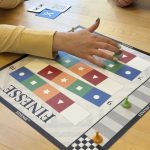Most casino games have a fixed edge and it is always in the house’s favor. But in blackjack, the advantage swings back and forth between dealer and player. Read on for some tips on how to broaden your advantage.
Reduce the House Edge in Blackjack

Reduce the House Edge in Blackjack
by Michael Wiesenberg © 2019 Great Bridge Links
Most casino games have a fixed house edge, ranging from as low as 1.36% to as high as 29%. The best you can find is blackjack (21) played optimally, wherein you can reduce the house edge to under 0.5%.
Most casino games have a fixed edge and it is always in the house’s favor. But in blackjack, the advantage swings back and forth between dealer and player. The house has the edge more often than the player and that is how they make money against most players. Betting more when the edge is in the player’s favor and less when not can be accomplished by counting cards. This is not an easy task. It’s hard to keep track of all the cards as they appear. And then mathematical gyrations must be performed in your head with the appearance of each card. The playing decisions change depending on what cards appear. For example, if you are counting cards sometimes you stand with a total of 12 versus the dealer’s 10 upcard, while sometimes you hit 16. Add to that the fact that casinos look for and bar card counters, to get around which card counters may resort to disguises and also modify their play to escape notice, which practices further lower their already small edge. Counting cards has become even tougher than what is depicted in the movie 21. Now casinos use computers to ascertain whether a suspected card counter actually is counting.
You can do something perfectly legal and safe to reduce the house edge. It’s called research, and there’s plenty of information available. If you learn blackjack basic strategy, which you can find online, and which does not involve counting cards, and learn how to find the best games, you can reduce the house edge to 0.5% or less.
Memorize the Tables
So first memorize the tables associated with basic strategy. The best are on the Wizard of Odds website. Then comes your research. Look for casinos that have as many of these features as you can find. Gambling venues like Las Vegas, Reno, Atlantic City, Biloxi, Monaco, Macau, and San José (Costa Rica), and many more, all have multiple casinos. The more casinos, the better the selection; the better the selection, the likelier to find games in one area with favorable rules.
Early Surrender
You can find lots of rules variants. The most favorable for players is early surrender, which, when played properly, reduces the house edge by 0.6%. This variant used to be more widely offered; now most casinos do not have it. (Generally, the casinos that do offer surrender usually have late surrender.) With early surrender, a player can give up half their bet and throw away the hand before the dealer checks their hole card (and potential blackjack hand). Correct early surrender strategy can be found online.
Doubling Down
Doubling down on more than two cards decreases the house edge by about 0.2%. Used to be casinos would allow a double down on the first two cards only. Many of today’s casinos allow doubling down on three or more cards. It used to be that players could double only on totals of 10 or 11. The house edge is further reduced if players can double down on any total. (Caveat: if played correctly, and for that you need to find the basic strategy.) Doubling down after pair splitting decreases the house edge by about 0.14%. Years ago most casinos would allow pairs to be split, and to hit or stand on each of the new hands, but doubling down wasn’t allowed. Most casinos allow it now.
Split
Drawing to split aces decreases the house edge by about 0.14%. Most casinos allow you to form two hands if your first cards are aces, but then you get one card only on each. Some casinos allow you to play those as two new hands, drawing to each as you wish. If you can further split aces that decreases the house edge by a further 0.06%.
Late Surrender
Late surrender is the main form of surrender offered by casinos. You still get to surrender your hand and lose only half your bet, but only after the dealer checks their hole card. If they have a blackjack, you lose the full bet, that is, the option to surrender is no longer available. Late surrender decreases the house edge by about 0.08%.
Multiple Decks
Multiple decks increase the house edge. If the rules are otherwise the same, six or eight decks increase the house edge by about 0.5%.
Winning blackjacks (an ace plus a 10-count card — a 10, jack, or queen) normally pay 3-to-2. You bet $10 and win $15. The worst rules variant for players is 6-to-5 blackjack. You bet $10 and win $12. Many casinos offer this variant, particularly on single deck games. Doing so increases the house edge by about 1.36%. In fact, if you have a choice between a single deck game that offers 6-to-5 blackjack and a multiple deck game that has 3-to-2 blackjack, you’ll fare better in the multiple deck game. If you don’t have a choice and all the blackjack games have 6-to-5 blackjack, you’d be better off playing craps — or finding another casino.








